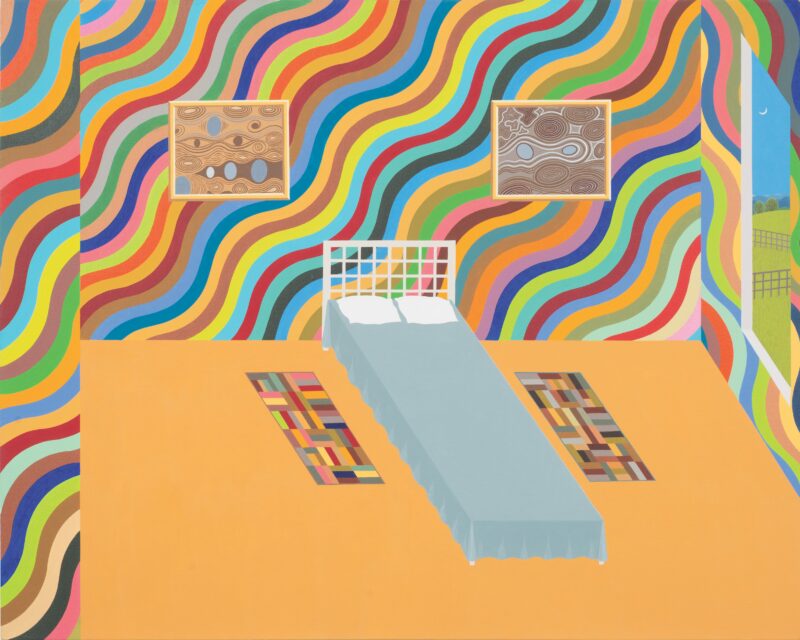
December 19th, 2024 | Issue one hundred forty-eight
The Fourteen Best Exhibitions of 2024 (According to Us)
Our far-flung correspondents report on the best art shows they saw this year
Fun-A-Day
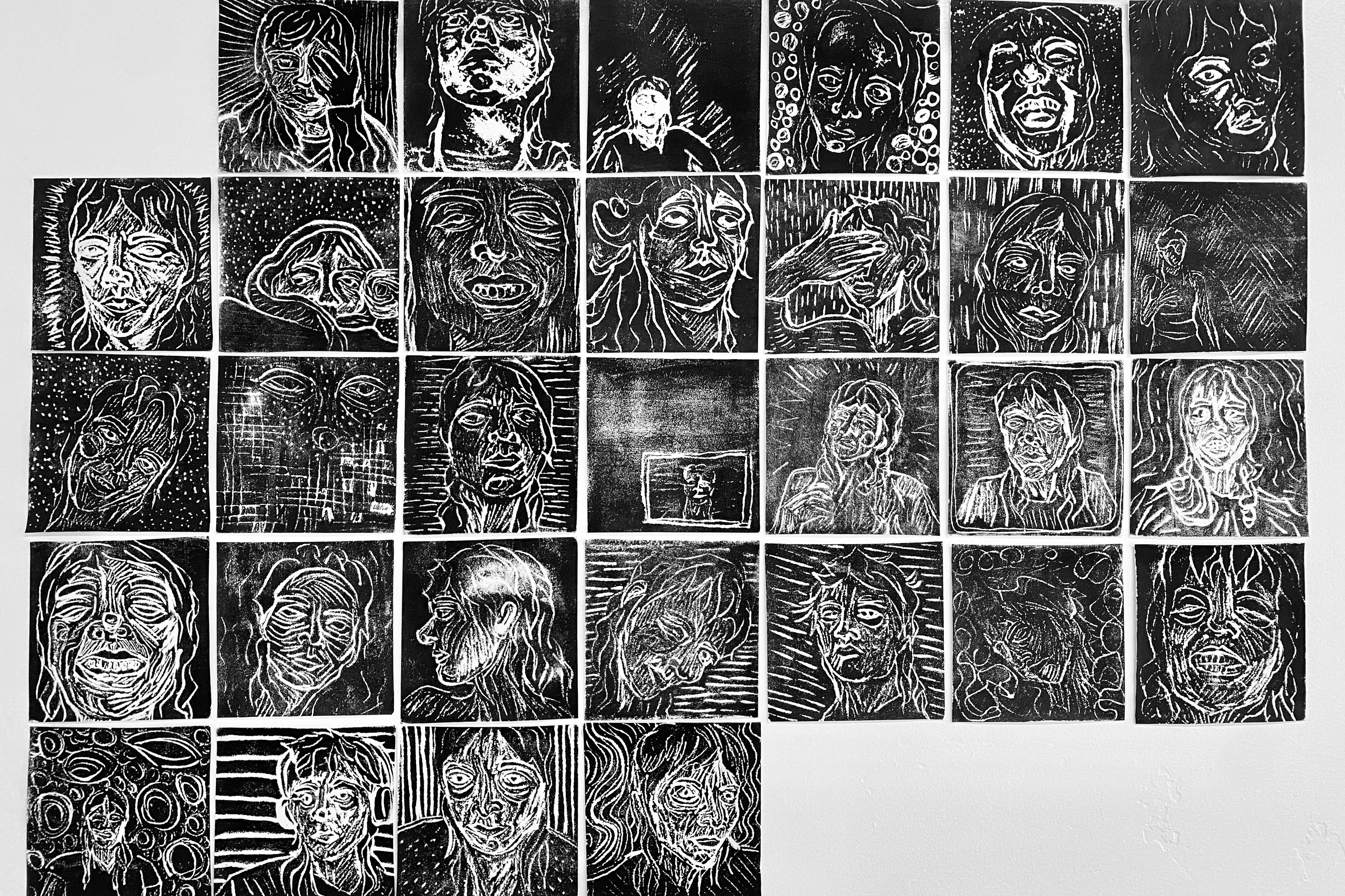
Artists: Various
Gallery: Fourteenfifteen/Alpaca
City: Albuquerque, NM
Fun-A-Day, now in its tenth year, is a celebration of the art of daily practice and of community. Participating artists create art every day for the month of January, and the resulting body of work is shared in a large group exhibition. Forty-three artists participated in 2024, and their work was thoughtfully curated in two modest exhibition spaces in the Barelas neighborhood of Albuquerque.
The exhibition creates space for experimentation and serves as a call for artists to reconnect with the intention surrounding their practice by asking, simply: Why do we do what we do?
I Tasi: Connections in Between
Artist: Connie Ann
Gallery: Kaleidoscope Studio
City: Las Vegas, NV
Tasi, which means “ocean” in Chamorro, was everywhere in Connie Ann’s June 2024 show at Kaleidoscope Studio in Las Vegas. Connie is a local photographer and artist, with roots in Guam. She specializes in cyanotypes, some as dark as ultramarine pigment, others faded, like a sliver of Las Vegas sky. On one wall of the exhibit hung a large cyanotype printed on fabric. A human figure with long flowing hair left their mark in the center of the fabric, surrounded by objects. Their outlines were crisp. On a bench next to the piece were vases, shells, flowers—all featured in the cyanotype.
On the far wall was a collection of smaller cyanotypes, hung with clothespins from netting. There were portraits of Connie’s loved ones and bits and pieces from Connie’s travels in Guam. The prints resembled hazy memories, and made me wonder what it would be like to yearn for an ocean home while living in this desert city. They were a form of recollection, a step against erasure.
A Berry, A Boot, A Building, A Blue Door
Artist: Mike Young
Gallery: Elbow Room
City: Portland, OR
A Berry, a Boot, a Building, a Blue Door featured many of Mike Young’s colored-pencil drawings on white paper—arrangements of bottles, animals, furniture, fruit—often outlined in ink with dimensions that leaned and tipped unexpectedly. The exhibition was guest-curated by Kristan Kennedy, artistic director and curator of visual art at the Portland Institute for Contemporary Art, and was held at Elbow Room, an art studio and gallery in Southeast Portland that provides “material support, mentorship, and meaningful exhibition and collaboration opportunities for artists with intellectual and developmental disabilities.” As I peered closely at the pages, Young’s dancing shapes began to evoke an illusion of motion, becoming a kind of visual stim. I felt I had entered a realm of sensory intrigue, a place to be curious about Young’s arrangements and his ineffable sense of how things fit together and belong.
petrichor
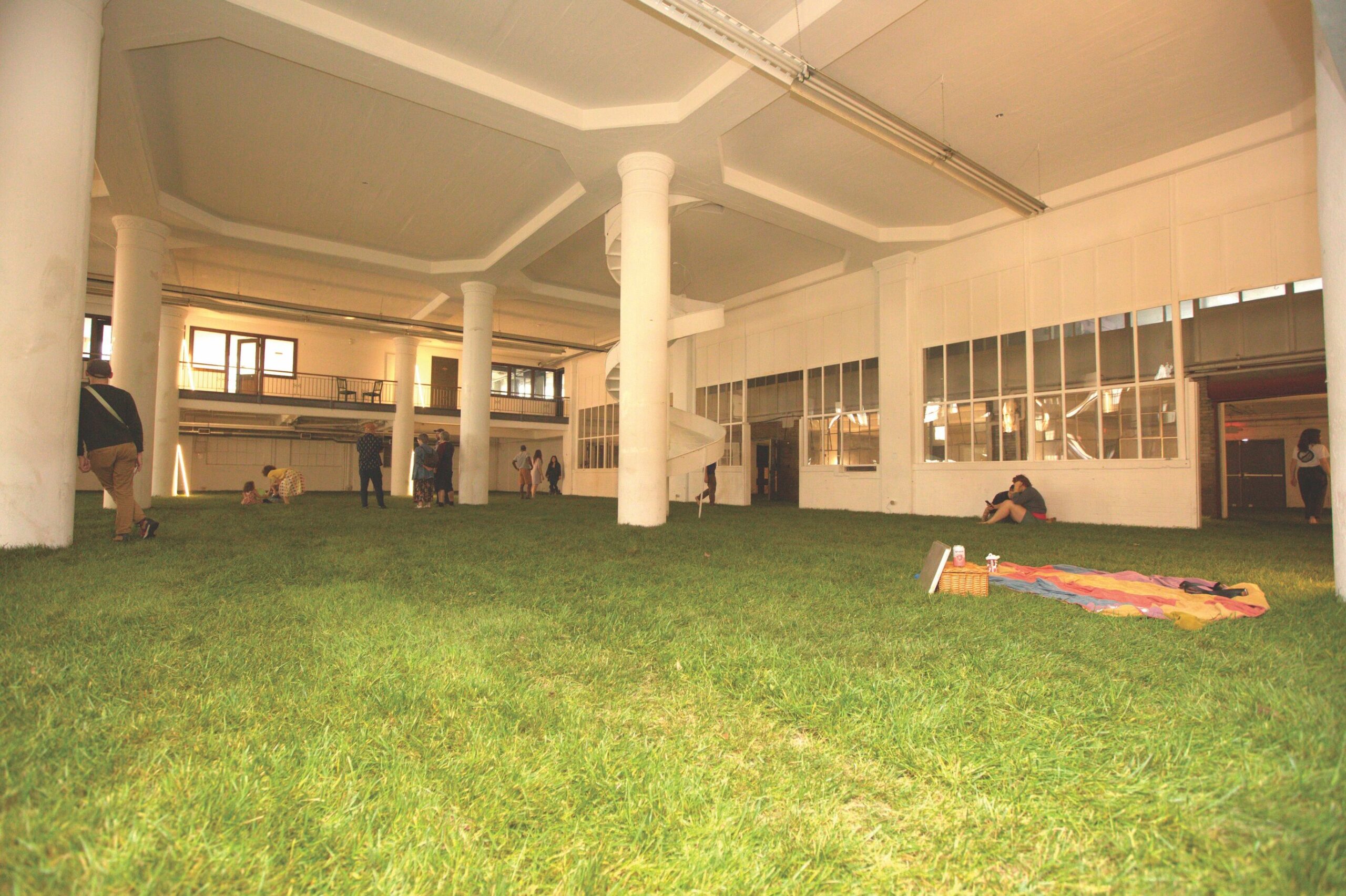
Artist: Lisa Waud
Gallery: Boyer Campbell Building, Detroit Design District
City: Detroit, MI
I often assert that artists aren’t wizards who conjure art out of thin air, but Lisa Waud’s ability to make entire realities wink in and out of existence over the course of a long weekend verges on the uncanny. I visited her series of three installations during her residency at the Detroit Design District’s Boyer Campbell Building in the summer of 2024, and I confess I’m still not sure how she laid down a carpet of sixteen thousand square feet of living sod for petrichor, then made it all disappear. She might be a wizard after all. Detroit is given to entropic spaces—houses and businesses that have been reclaimed by the churning biomass—but the pairing of tidy monoculture and industrial abandon made a new alien place: The Stepford Wives meets Ford Motor Company. One could play croquet, or observe the decay, or sit and smell the humidity hanging in the air. There’s more than one way to touch grass.
As for me, I’m just passing through this planet
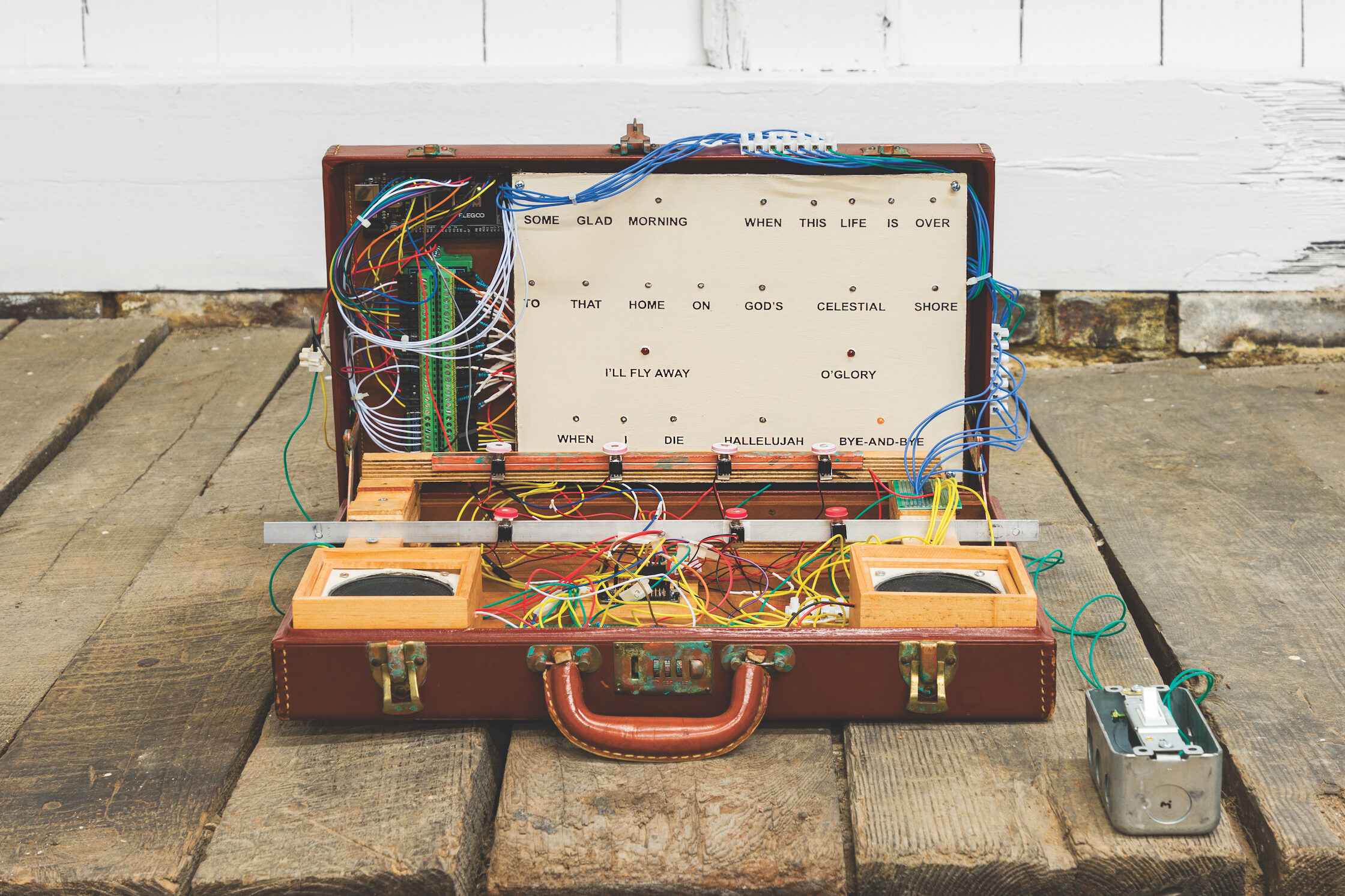
© 2024 by Caitlin McCann
Artists: Jacob Jackmauh, Caitlin McCann, and Benjamin Stallings
Gallery: Bad Water
City: Knoxville, TN
The title, a quote from perpetually tapped-in Southerner Howard Finster, describes how I felt as I stumbled into this exhibit—and into Knoxville. A newcomer here, I was led to the outbuilding of a house where the director of Bad Water gallery, curator Kelsie Conley, once lived. This nimble shed-gallery is at the confluence of professionalism and DIY. The walls were gallery-white, yet barnlike. The floor I can describe only as “clean dirt.”
Jacob Jackmauh’s haunted fiberglass readymades spoke first. The lichen-marked fragments of discarded hollow animals sprouted from Bad Water’s inherent in-betweenness. Meanwhile, Caitlin McCann’s improvised audio contraptions—a wire-stuffed briefcase, a see-through telephone—interposed some stilted, faraway folk tunes. A chapbook by Benjamin Stallings evoked the region’s omnipresent kudzu as both affective and arterial. The fact that the first two artists live in New York, as I had just finished doing, was meaningless in the tangle of vines. Next door, some dogs barked.
Decomposing Fem
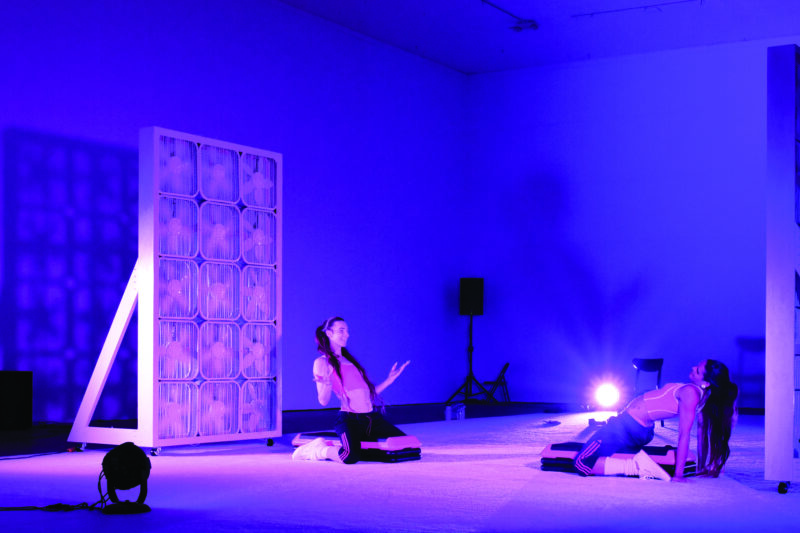
Artists: Gwendy Smith and Fyre Wood
Gallery: Icebox Project Space
City: Philadelphia, PA
In spring 2024, I attended a haunting and captivating performance, Decomposing Fem, at Icebox Project Space in the South Kensington neighborhood of Philadelphia. This evening-length piece was choreographed and performed by Gwendy Smith and Fyre Wood; Kat Nzingha crafted the sound score.
Gwendy and Fyre spent three years creating this piece, their first performance together, which centered, highlighted, and generated opportunities for queer, trans, and gender-nonconforming people. It showcased a radical environment crafted to hold shifting and morphing bodies during a time when their safety and existence are threatened. The performers invited the audience to feel a spectrum of emotions, ranging from love, fear, and power to pain and infatuation.
INTO THE BRIGHTNESS: ARTISTS FROM CREATIVITY EXPLORED, CREATIVE GROWTH, AND NIAD and CREATIVE GROWTH: THE HOUSE THAT ART BUILT

Artists: Various
Museums: Oakland Museum of California and SFMOMA
Cities: Oakland and San Francisco, CA
Just in time to celebrate Creative Growth’s fiftieth anniversary, two museums, in Oakland and San Francisco, celebrated an essential and often-overlooked group of artists from Creative Growth, NIAD (Nurturing Independence Through Artistic Development) Art Center, and Creativity Explored in back-to-back exhibitions in 2023 and 2024. These three organizations, which support the vision—and now the careers—of artists with developmental disabilities, are critical to the political and social ethos of the Bay Area arts community. How novel it was to feel excited and refreshed in a museum, and to be reminded that some of the most important art in the world is being made locally. Work by fan favorites Camille Holvoet and John Patrick McKenzie carved out some of my favorite comedic moments in the exhibitions, and William Scott’s extraordinary mural Praise Frisco: Peace and Love in the City projected a contagiously optimistic energy for a future that’s right around the corner—if we want it.
Angisa: A Language of Living

Artist: Cornelius Tulloch
Gallery: Andrew Reed Gallery
City: Miami, FL
Since meeting Cornelius Tulloch three years ago, I’ve watched the twenty-seven-year-old multidisciplinary artist’s career soar, from Miami to New York to Paris to Venice. But no matter where his art takes him, he always makes it back home. Angisa is the paragon of Tulloch’s signature style and work ethic. Inspired by Tulloch’s residency in Suriname, he and gallerist Andrew Reed transformed the gallery, in Miami’s Allapattah neighborhood, with mustard-colored walls and elaborate wood carvings. Tulloch painted jewel-toned portraits and serene landscapes that captured Suriname’s beauty and serenity. For years, Tulloch has worked hard, taking little time for himself in between ambitious exhibitions and prestigious residencies. The Suriname residency was “the first time I’ve ever really slowed down in my life,” he said. The result was a collection of works that show off Tulloch’s diverse skills and distinctly South Floridan point of view. As a native Miamian, I’ve found it hard to put into words the essence and aesthetics of this larger-than-life Caribbean American city. But I don’t have to. I can point you to Tulloch’s work instead.
Being There

Artist: Rebecca Shore
Gallery: Corbett vs. Dempsey
City: Chicago, IL
This show featured Rebecca Shore’s geometric paintings of domestic architecture, the clinical rigor of which belies their strange poignancy.
Beds—solitary and in pairs—appeared in plain gray rooms, empty of inhabitants and free from conventional pictorial perspective. Barren trees and empty trellises were paired with new shoots in garden planters. Beaded curtains, doors left slightly ajar, and stairways leading nowhere were recurrent motifs that suggested a space beyond that was unavailable or murky.
Mountain landscapes appeared as paintings within paintings, juxtaposed with “real” scenes of rolling hills and pastures seen through windows. The moon was a fugitive motif, hiding out in the paintings’ “real” and “fictitious” landscapes, illustrating the thrilling and alienating quality of all representational art: the idea that what is depicted is not really there.
“MOMENTARY LAPSE OF REASON” and TIME SNAIL ROMAN
Artists: Rigo Alberto Zamarrón and Eva Claycomb
Galleries: galerie ego and Do Right Hall
City: Marfa, TX
Rigo Alberto Zamarrón showed at galerie ego, which is in the laundry room of a private home. Lighting was supplied by clamp lamps affixed to an upside-down ironing board. One person or two intimates could view the show at once. Rigo’s paintings are smallish, about thirty inches across and twenty inches vertical. The energy is circular, one wanders o’er the whole of the painting swiftly, and abstract shapes fade in and out. I think of Amy Sillman and Carrie Moyer as kin but Rigo has a swoop.
Eva Claycomb at Do Right Hall makes illusionistic work. Her small and slightly larger squares of muted colors and natural tones could be architectural details, cornices. They have the authority of stone but close up you see that it’s indented cardboard that feels emblematic and strong. There was a lizardy lime green and a blue gray that could form an entire city. The sexiness of these squares is linguistic and tart. She thinks big and delivers small parts of a built world she winkingly knows.
Azaleas
Artist: Lotus L. Kang
Gallery: Commonwealth and Council
City: Los Angeles, CA
It has been impossible for me to forget Lotus L. Kang’s show Azaleas, in which photographic and sculptural materials make up ephemeral installations. In the first room, curtain-like sheets of unprocessed large-format film were draped over one another, developing moment by moment, as they displayed the impermanent colors of a dry mountainside. The installation’s infrastructure included cast flora, such as lotus roots and seaweed, along with tender details like the red plastic netting that holds pieces of imported fruit together. The second room was particularly magical: a tremendous apparatus, a spool twirling filmstrips, hypnotically rotated forward and back. A set of lights behind the machine illuminated images from the filmstrips in a nearsighted blur throughout most of the room but maintaining sharp focus on one small patch. Using temporality to explore a sensory relationship to loss, longing, and separation, Kang highlights a recurring experience of psychic melancholia seemingly inseparable from a postwar Korean identity. She translates the delicate process of working through one’s sense of severance, rediscovering what was lost, only to lose it again.
Woven

Artist: Jeremy Frey
Museum: Portland Museum of Art
City: Portland, ME
This summer, in a darkened corner of the Portland Museum of Art in Maine, I was captivated by a video of Passamaquoddy basket weaver Jeremy Frey single-handedly felling and breaking down an ash tree. Frey comes from a family of basket weavers, and he follows their centuries-old style of gathering materials, but his results diverge from tradition.
The works featured his innovative techniques, like nested baskets whose interiors were patterned differently from the exteriors. The effect was heightened by his use of synthetic dyes: saturated colors lent a surreal quality to urn-like shapes woven into purple- and red-checkerboard or teal stripes, while squat “point” baskets, whose spiky exterior was meant to resemble the spines of a sea urchin, looked downright mad, armored in fluorescent orange.
At the end of the video, which was titled Ash, Frey set on fire the basket he had labored over for many days. It was a startling image that revealed an anxiety about the legacy of this work: In the future, will the knowledge of this craft and the materials it requires still exist?
Micasa

Artists: Various
Gallery: Darryl’s UWS
City: New York, NY
Among this year’s many apartment shows, MiCasa was a standout. Its site-specific installations were a necessary and invigorating counterpoint to the antiseptic domains of white-cube galleries. Curators Amalia Ulman and Nick Irvin hosted this group show in their newly purchased, unrenovated Housing Development Fund Corporation apartment on the Upper West Side, in New York City, formerly home to a pair of brothers—both Gen X gamers with otaku inclinations—and one of the brothers’ two daughters. The show unspools around the signs of life left behind by the tenants. Children’s crayon doodles, scrawled across peeling, cerulean walls, skirt the edges of featured works like Magnus Peterson Horner’s moon-eyed portrait of a little boy, and Louis Osmosis’s delightfully off-kilter sculpture.
In one room, which had been used as a “game dungeon,” Alex Mackin Dolan’s metaphysical reinterpretation of a retro Sega video game interface shares a wall with computer monitor mounts left over from the brothers’ elaborate gaming rigs. More subtle interventions, like Whitney Claflin’s sinister soot message smudged onto the apartment’s kitchen ceiling, blur the line between what is being introduced and what has been left behind. Within these constructed intimacies, the works serve as a connective tissue, reanimating the apartment’s past lives. Part homage, part bizarro open house, MiCasa straddles the public and the private, the real and the imagined. The show offers a thoughtful exercise in what preservation and memory might look like in a city that always seems to be changing.
Material Memory
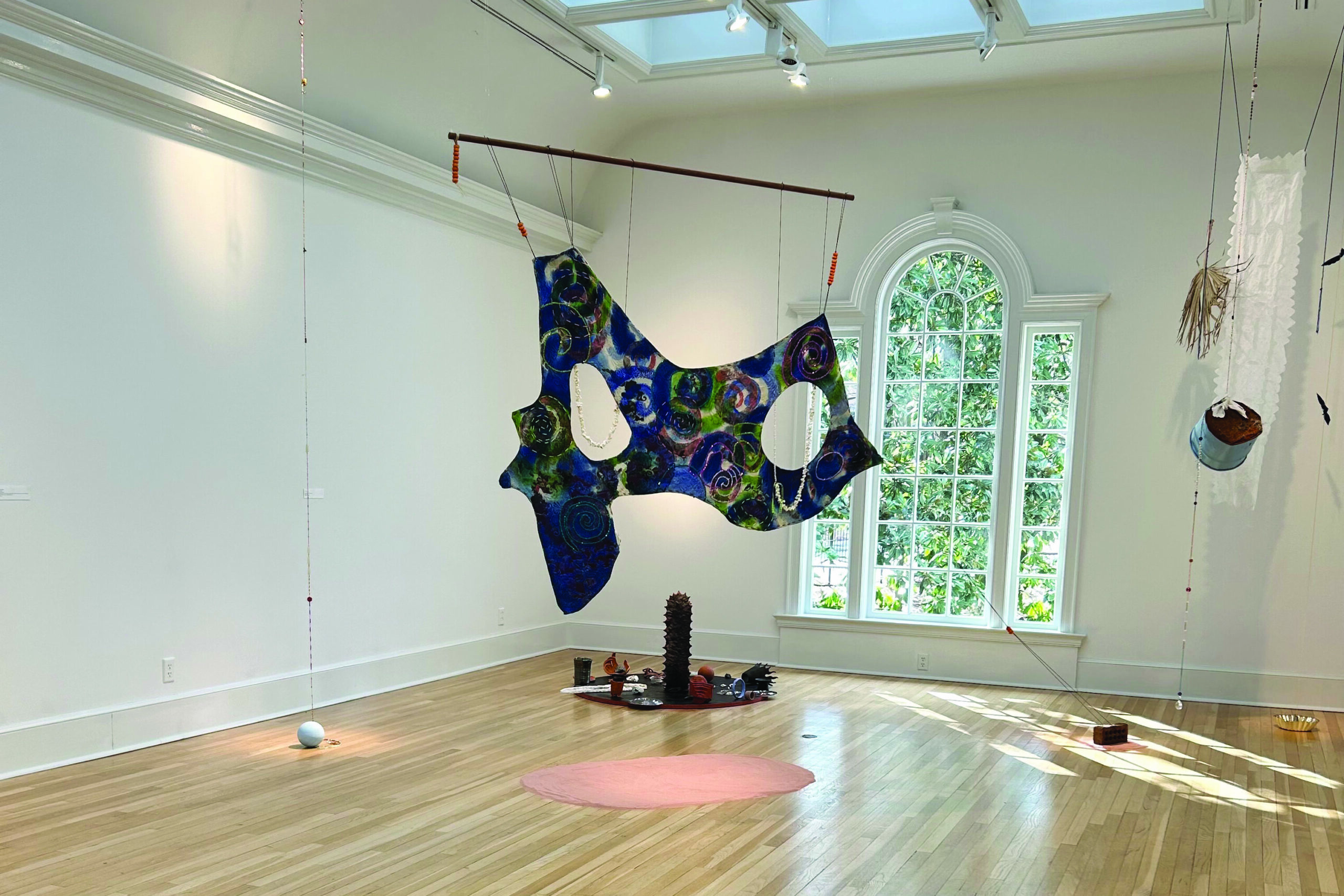
Artist: Kelly Taylor Mitchell and Sergio Suárez
Gallery: Swan Coach House Gallery
City: Atlanta, GA
This two-person exhibition, curated by TK Smith, included ceramics, textiles, drawings, and homemade paper, and incorporated found and natural materials like bricks, sand, and leaf fronds. Mitchell’s work—dynamic, abstract shapes tethered by beaded string—hung vertically, while Suárez’s sinewy, spiky ceramics were gathered on painted circular platforms on the floor. The exhibition description and the handmade objects both alluded to the theme of spirituality, but I found this most evident in the physical interplay between the artists’ domains. Magic occurred when the skyward-reaching forms dared to nearly touch the earthly vessels. Two-person shows can be tricky: often the included works can feel either oppositional or too similar. Yet these artists were graciously responsive to each other in both grand and small ways.




